Here in Canada, it’s winter for a good portion of the year so it’s essential to learn how to safely and comfortably get out year round. The options are endless in the winter, from hiking to snowshoeing, to cross country skiing, skating and sledding, you can for sure find something that you enjoy to do with your kids. The short days can impact my mood a lot so it’s essential for me to get outside every single day.. and that means that my daughter comes with me too. I’ve been wanting to put together a guide about winter hiking with babies for a while now and I’m so excited to finally have this out!
Disclaimer: This article contains affiliate links, should you purchase anything from these links I may receive a small percentage commission at zero cost to you. This helps support the blog and allows me to create new content for you all.
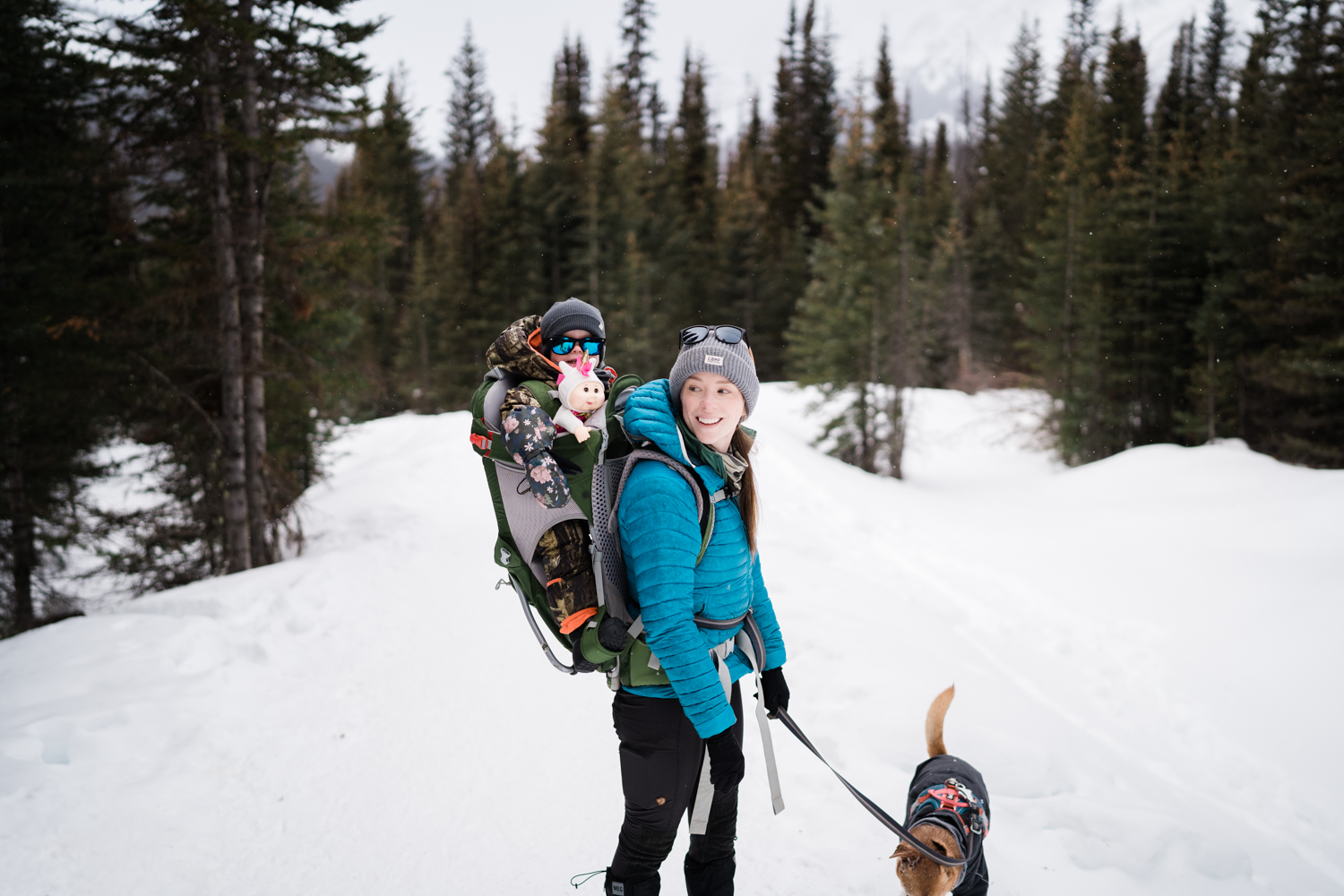
Is it safe to hike with my baby in the winter?
Let’s start off with the safety considerations. It can be scary when you first start to think about winter hiking with babies AND it’s absolutely safe to hike with your baby in the winter. Obviously, you have to keep in mind the temperatures (and the wind chill), but for the most part, we are able to get outside nearly every day up here in Alberta (definitely not on those -40C days though). My daughter was born at the end of November, and she was outside consistently starting around 3 weeks old. Make sure you listen to your own body though and take things at the pace right for you. Read on to see how best to prepare to have a winter full of winter activities with your baby and toddler!
Tips for winter hiking with babies
Winter adventures require a bit more planning but are oh so worth it. Here are some things to consider:
- Check the weather to ensure you know what you’re going out in
- Check the road conditions
- Pack lots of water in an insulated bottle (not in your hydration bladder) and things to stay hydrated (soup in an insulated food jar, hot chocolate, etc). Bring food for your toddler that won’t freeze and be too hard to eat (we just do a lot of hot dips in those food jars).
- Know what hypothermia in babies looks like
- Know what overheating in babies looks like – I know this seems counterintuitive to think about when winter hiking with babies but honestly, Aster was more often too hot because I would go overboard with the layers in the beginning until I got more comfortable knowing how to dress her. Frequently check on them to make sure they’re not red or flushed or sweating at all.
- Bring the 10 essentials and always tell other people your plans.
- Pack extra clothing for your baby and toddler and change into their wool base layers in the car once you get to the trailhead in case of carseat diaper disasters.
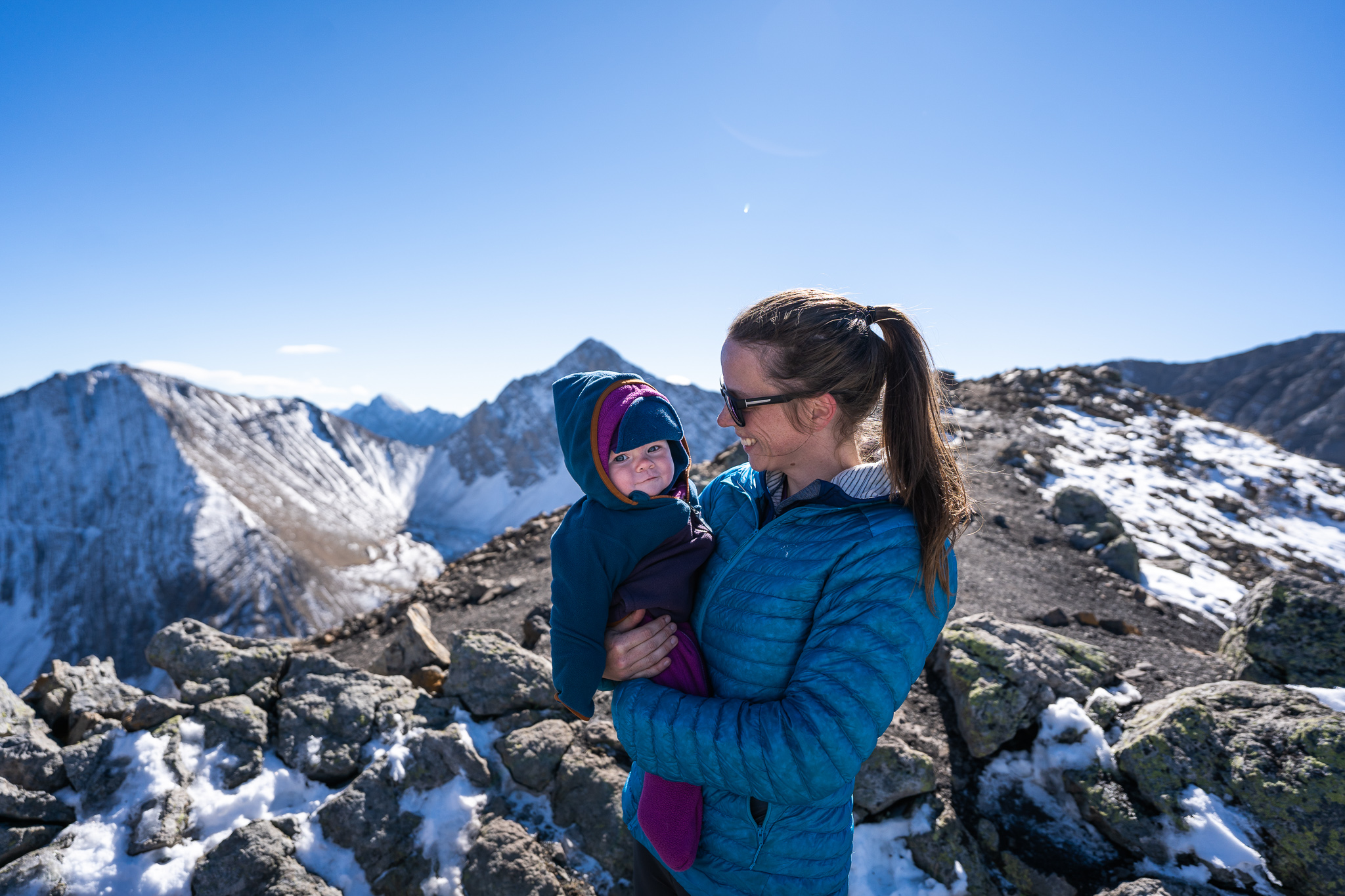
How do I keep my baby warm while hiking in the winter
Layers are the most important thing here. And to be honest, it’s not much different than how you would layer your clothing. There are 3 general layers that make up a good system: 1. Base layer 2. Mid layer (insulating layer) 3. Outer layer (shell). The general rule of thumb is that your baby should be wearing one more layer than you. You will have to consider if you will be wearing your baby under your jacket or overtop of it. If you have your baby under your jacket, you will be sharing your body heat and your jacket will do some insulating, so you won’t have to dress your baby in as many layers. If your baby is in a carrier on your front, they will still get some of your body heat compared to when they are in a backpack carrier. So keep that in mind when selecting layers before you head out hiking.
The Best Cold Weather Gear for Winter Hiking with Babies and Toddlers:
Base Layer
Base Layers are meant to be worn first (so closest to your skin) and their purpose is to wick sweat away which helps keep you warm. This layer is typically made from either wool (natural) or polyester (synthetic), it should never be cotton.
Merino wool is the quintessential base layer for adults and littles alike. Merino wool is a natural fibre from the Merino breed of sheep in Australia and NZ. It’s the softest of all the wools and has the greatest benefits. Merino wool is thermoregulating (so it keeps you cool in the summer and warm in the winter), odour resistant, quick drying, durable, UV resistant, and much more.
If you’re looking for a less expensive base layer, look into synthetic fibres such as polyester. It offers a bit more durability and will also keep your littles nice and warm.
For babies, I like the full onesie style base layers because then I don’t have to worry about drafts. For my toddler, it’s much easier to have the bottom and top combination to facilitate easy bathroom breaks.
Baby and Toddler Base Layers:
- Wee Woollies, a Canadian brand committed to being socially responsible who uses no hard chemicals during processing and uses non-toxic dyes. They have lasted great for us and I’ve been able to score some used on Facebook Marketplace so that is always a win.
- Baby Capilene® Midweight Henley (synthetic)
- Baby Capilene® Midweight Bottoms (synthetic)
- MEC T2 Merino Base Layer Bottom – Children
- MEC T2 Merino Base Layer Long Sleeve Top – Children
Mid Layer
This is the insulating layer that traps all the heat in. Depending on the temperature and the wind, I will decide whether I go base layer + fleece layer (warmer, no wind), base layer + down layer (colder, some wind or weather), or base layer + fleece layer + down layer (really cold days).
Baby and Toddler Fleece Layers:
- MEC Fireside Bunting Suit – Infant
- Columbia Infants Snowtop II Bunting
- Jan & Jul Fleece Suit – Infant (Aster fit into the 12-18 month one until she was ~2.5 years) (use code domcarson2410 for a discount!)
- Patagonia Micro D Snap-T Jacket
- Jan & Jul Kids Fleece Jacket (use code domcarson2410 for a discount at Jan and Jul!)
- Jan & Jul Kids Fleece Pants
- Carter’s fleece sleepers (you likely have some of these already and they’re a great option to get paired underneath a down layer)
Baby and Toddler Outer Layer
On most days, my chosen outer layer is one of the snowsuits listed below. They’re insulated and weather proof which make for a great option. I love infant snowsuits that have fold over hands and feet to keep all their warmth inside.
Baby and Toddler Down Layers:
- MEC Toaster Bunting Suit – Infants
- MEC Besnow Bunting Suit – Infants
- Patagonia Baby Hi-Loft Down Sweater Hoody
- Patagonia Infant Hi-Loft Down Sweater Bunting
- Jan & Jul Baby Snowsuit (use code domcarson2410 for a discount at Jan and Jul!)
- Jan & Jul Kids Waterproof Snowsuit
- Columbia Down Bunting Suit
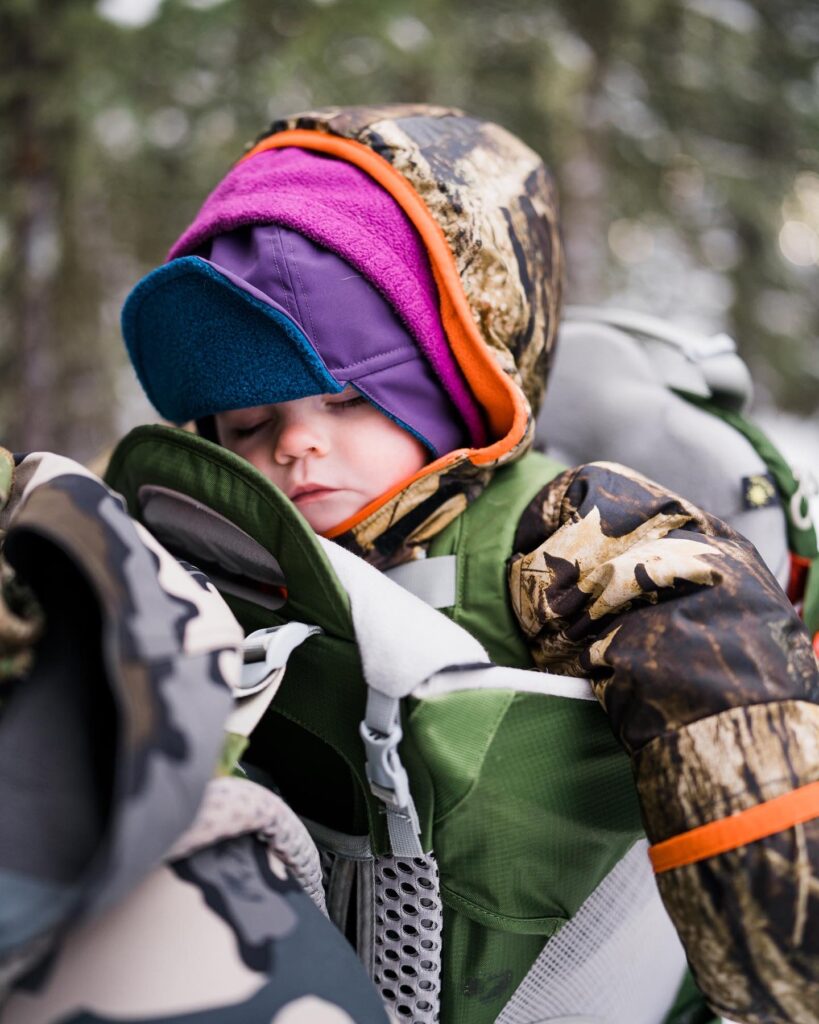
Footwear
For babies that aren’t walking, it’s totally okay to just have socks on and then their insulating layers overtop. They tend to stay pretty toasty warm. But if you do want a few options, below are a few we used and liked. For toddler boots, I look for lightweight, waterproof boots that are easy to get on. My suggestion is to size up for the winter boots so that you can fit a thicker pair of wool socks underneath.
Baby Winter Boots:
- Stonz Puffer Booties – use code DOMC10 for 10% off
- Jan & Jul Stay Put Cozy Booties (for warmer days) (use code domcarson2410 for a discount at Jan and Jul!)
Toddler Winter Boots:
- Stonz Trek Toddler – use code DOMC10 for 10% off
- Jan & Jul Kids Insulated Ankle Boots – use code domcarson2410 for a discount at Jan and Jul!
- Jan & Jul Kids Tall Winter Boots
- Kids Ice Cleats. I haven’t had the need to try these yet for our girl, but I will add a link here if we find a kind that works well for us.
Baby and Toddler Winter Socks:
For socks, I love buying wool socks in larger sizes and then they go way up to her knees and even have used bigger sized thick wool socks over her little hands/arms underneath her down suit for some extra warmth on cold days. Then they also don’t grow out of them as fast.
- Smartwool kid socks
- J.B. Field’s Hiker GX Merino Wool Hiking Socks – Infants to Children
- RedHead® 6-1/2” Cub Socks for Kids
Accessories
These are such an important layer and I usually pack a couple of different options with me in case anything gets wet. I like having a couple of different options of toques in case we need a thinner one to allow for a hood to go up or anything like that.
Baby and Toddler Toques:
- Carhartt® Youth Acrylic Watch Hat
- Jan & Jul Kids Beanie Hat
- Miles the Label Merino Beanie
- MEC Toaster Earflap Hat (I loved that it covered some of her cheeks as well)
Baby and Toddler Winter Gloves:
We didn’t really use mitts until over a year old because we just utilized wool socks on her hands underneath the folder over cuffs on her fleece or down suits. We liked the ones with cuffs that came all the way up to elbow as she got older because they stay on better.
- Jan & Jul Kids Fleece Mittens – use code domcarson2410 for a discount at Jan and Jul!
- Jan & Jul Kids Waterproof Mittens
- Stonz Snow Mitt – use code DOMC10 for 10% off
Baby and Toddler Neck Warmers:
- Jan & Jul Kids Neck Warmer
- MEC Kids Neck Gaitor
- Merino Wool Buff (we used an adult one on her a lot when it was really cold to kind of put it up onto her head and over her cheeks a bit too)
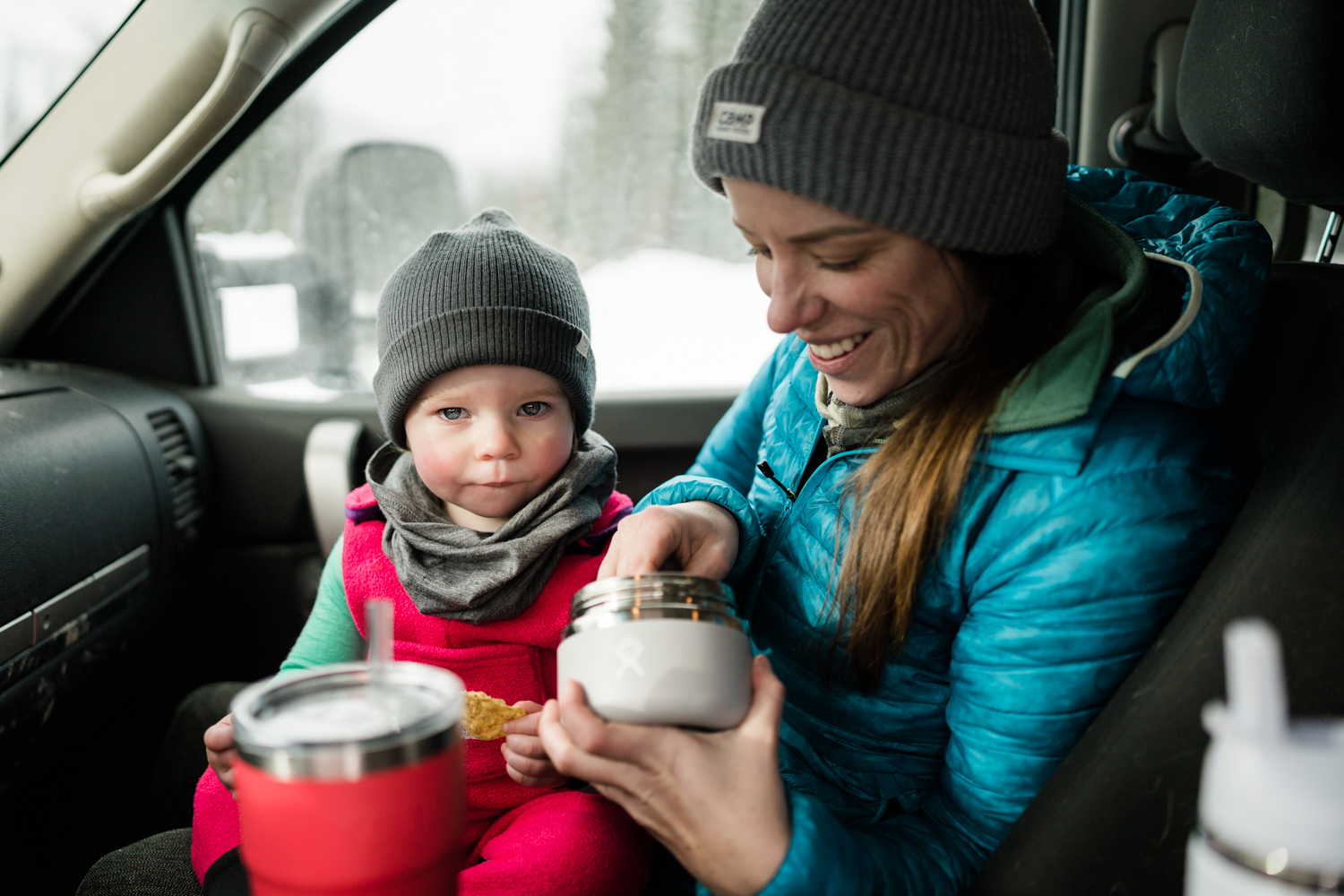
Baby and Toddler Sunglasses:
- Jan & Jul Kids Polarized Sunglasses – use code domcarson2410 for a discount at Jan and Jul!
- Stonz Eco Sunnies – use code DOMC10 for 10% off
It’s also important to remember that snow is really reflective so it’s really easy to get a sunburn in the winter. Be mindful of how much sun is hitting your babies face and use the sunshade, sunglasses, and sunscreen (if they are over 6 months).
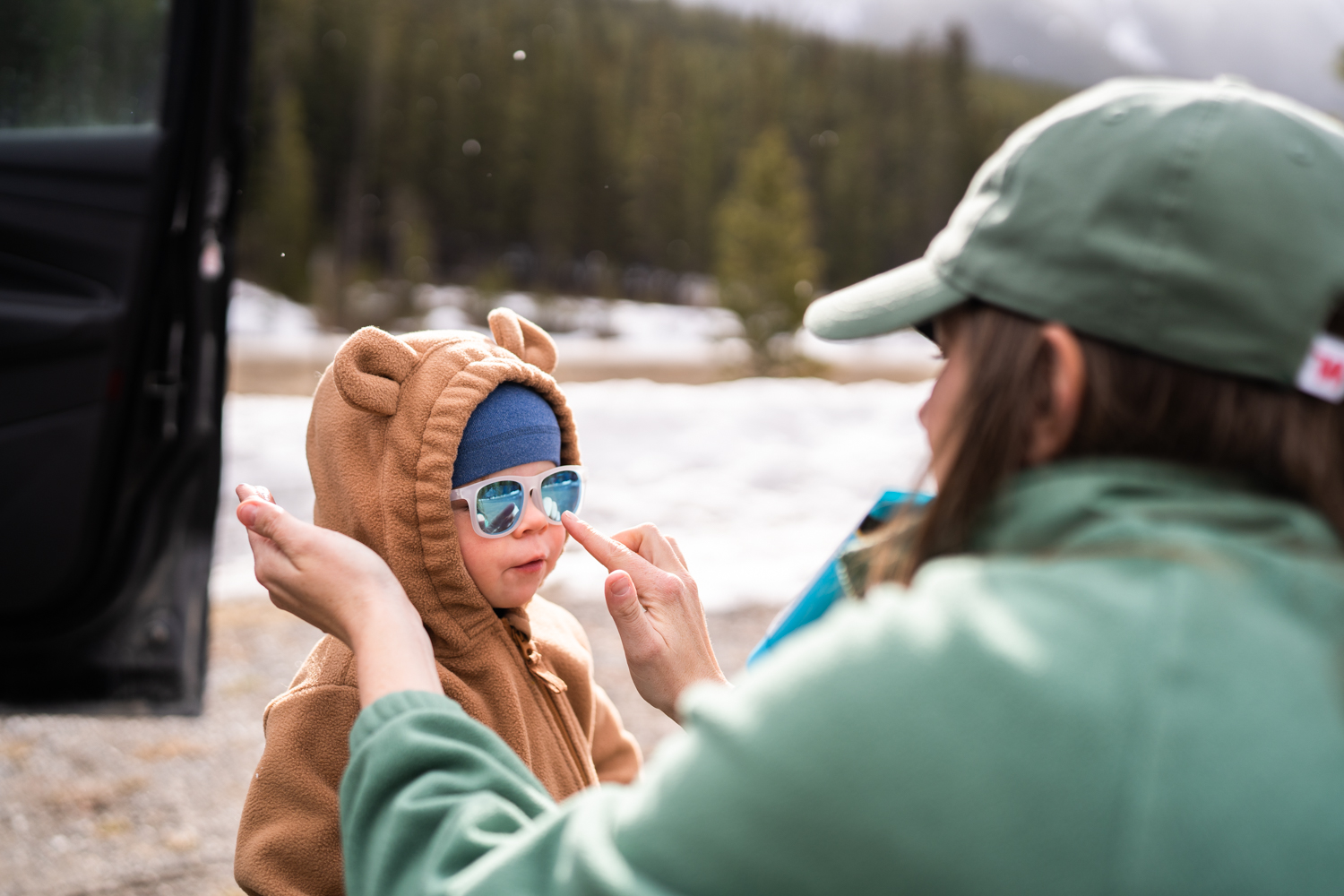
Baby and Toddler Hand Warmers:
It can be hard to keep toddler hands warm in some mitts so previously on really cold hikes I would pop a disposable hand warmer in each of my daughters gloves and that would help keep things warm. To be honest though, I would really worry about them being too hot and burning her hands. This year, I will be using Aurora Heat reusable hand warmers and I am SO excited about the much more sustainable option there. You can use code DOMCARSON at checkout to save 10% on your order.
How to carry your baby while winter hiking
There are a couple different options here and these might change as your baby gets older and you figure out what works best for you both. For the soft wraps and structured carrier, it’s important that you pick ones that promote good positioning of the baby so it is safe for their hips.
Soft Wraps
Soft wraps are nice when you have a newborn and you want to keep them really close to your body while hiking to share the heat. They are a bit harder to figure out how to use but once you get the hang of it, it’s pretty quick to wrap up and get your baby in and head out. You can get a bigger winter coat (I always wore my husbands) or a winter coat extender so that you can wear your baby under your jacket and know that they are warm from your body heat. Here are some soft wraps that I liked:
Structured Carrier
Once your baby starts to get a little bigger, it is nice to have a structured carrier for some extra support when winter hiking with babies. I found them easier to use also. With structured carriers, you can wear it on the inside or the outside of your winter jacket (depending if you have a big enough coat to zip up around it). Depending on which structured carrier you get, you may need to purchase an infant insert for it. Here was our fave:
- Ergobaby Omni 360 Baby Carrier Mesh – our fave carrier in the summer because the mesh makes it breathable and it is good from 7-45 lbs.
- Ergobaby All Weather Carrier Cover – this is a cover that provides some extra protection from the elements
Backpack Carrier
Once your baby is bigger, you can look into getting a backpack carrier for those longer excursions. These carriers function like backpacks and place most of the weight on your hips, which is much better for your back and shoulders. There are many different options and you want to find one that firstly, is comfortable for you and your little and also provides the extras that you want (like storage, sun shades, rain covers, etc). I definitely would recommend getting a sun shade if yours doesn’t come with one. When your baby or toddler is in these carriers they won’t be able to rely on any body heat from you, so now is when it’s really important to make sure they are layered up appropriately. Take breaks to check on them to make sure they’re still at a comfortable temperature.
These backpack carriers can be pretty expensive so make sure you check resale sites for used ones. Here is what we have and ones that friends have used and liked:
- Osprey Poco Child Carrier – the one we have and love
- Osprey Poco Plus Child Carrier (US link) (more storage than the one above so would work a bit better for backpacking with your toddler)
- Thule Sapling Child Carrier | US link here
- Deuter Kid Comfort Carrier | US link here
- MEC Shuttlecraft Kid Carrier
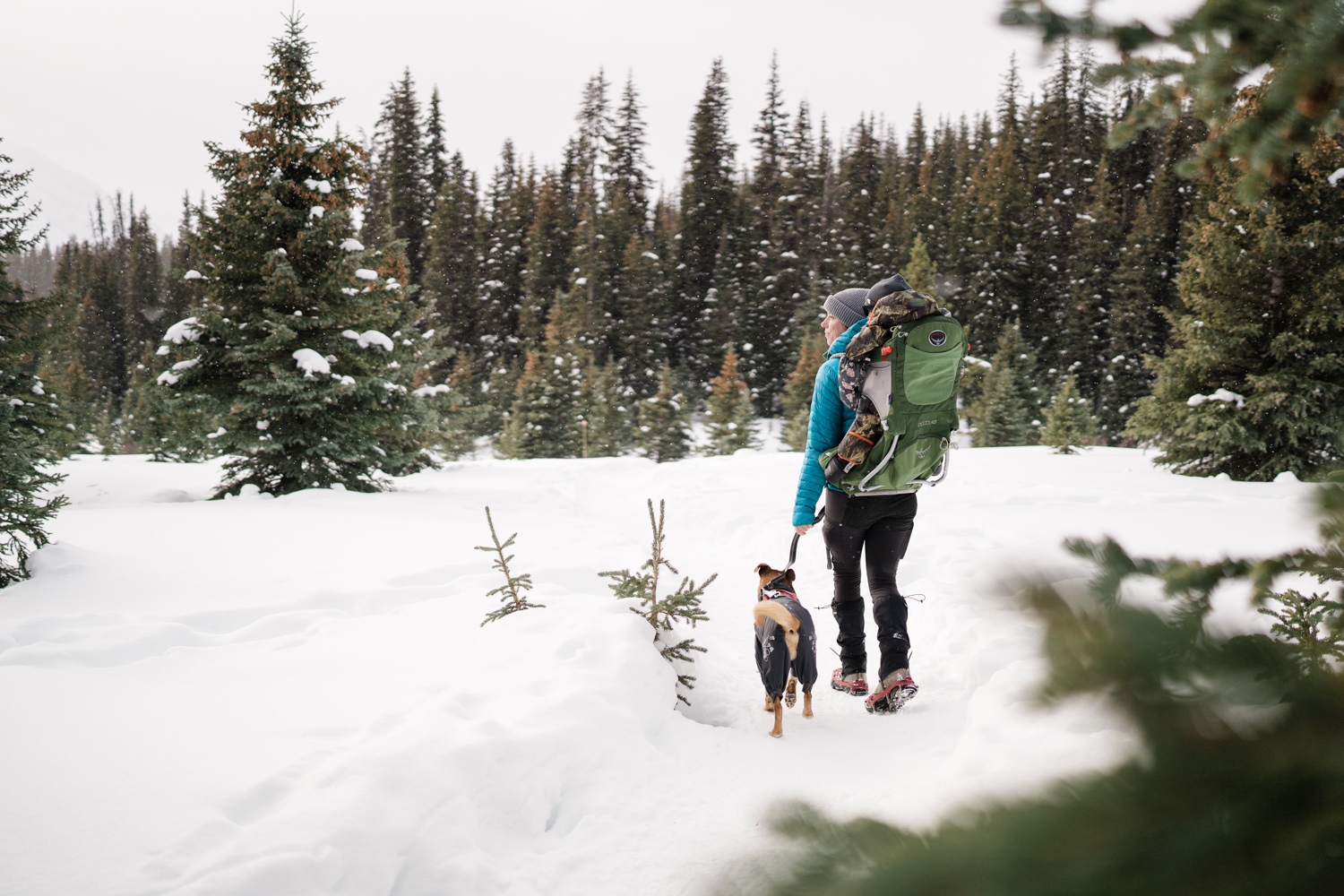
How to hike with your toddler in the winter
Once you have a toddler who wants to maybe walk a bit and maybe isn’t as into getting rides in the carrier anymore, don’t worry, you still have some options.
- Sled. We bring this shed hunting and on snowy hikes where we can maybe toboggan down certain parts. Our daughter will even nap in this occasionally.
- Chariot with ski kit. (US link here) Not just for cross country skiing. I have friends who would put the ski kit on and run the jogging wheel on the front to push along while snowshoeing adventures or use the ski kit to pull the chariot behind them while winter hiking or snowshoeing. I loved my chariot to cross country ski with our daughter, it was such a great way to bundle her up and spend a nap time. It was also nice to bring along with the regular wheels while doing paved pathways that had the snow cleared. Sometimes a chill walk out in the winter is much needed! You can get down bunting bags to keep them warm in strollers.
- Structured Carrier. Maybe you have a toddler who still loves the backpack carrier! Bring it along for when they need a little break.
- Trail Magik. Keep this in your backpack for when those toddlers need a little carrying time. It works wonders for me for short distances while our daughter recharges.
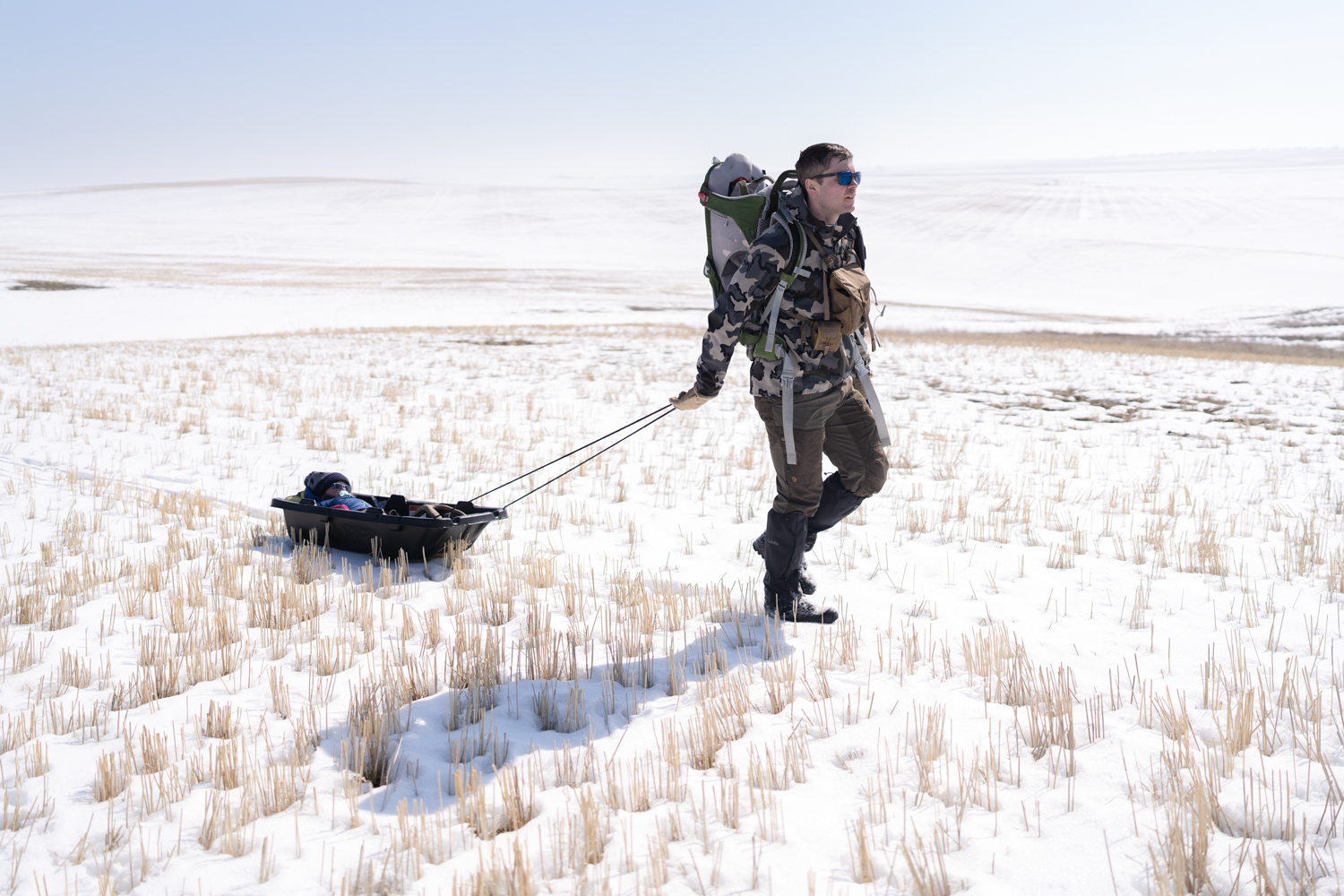
How to feed your baby while hiking in the winter
Feeding your baby when you’re not at home is always such a challenge in the beginning. It gets easier! For winter hiking, I always like to offer a feed (I breastfed, but insert whatever feed works best for you) while still in the car right before we start hiking. I knew that I had a two hour window ish and usually would pick a hike around that length in the beginning. Later on when we started doing longer hikes I figured out a system that worked for me.
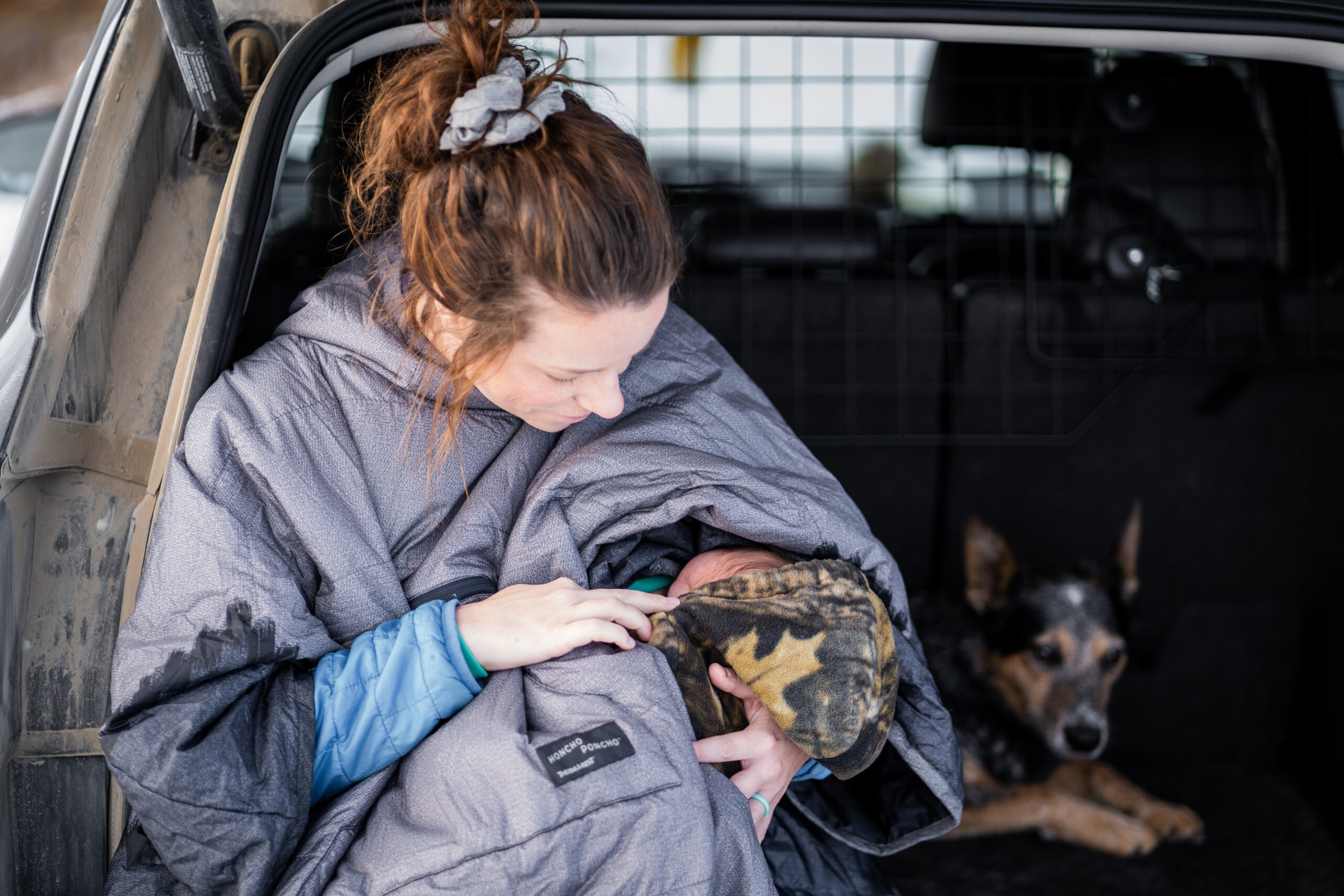
How to breastfeed while winter hiking:
- Offer a feed at the trailhead
- Wear a nursing or pumping friendly base layer (read my review of the Kojo Merino Breastfeeding Shirt)
- Bring a Therm-a-rest Z Seat for a place to sit off the snow and to keep your butt warm
- The Therm-a-rest Honcho Poncho (down version here) was a game changer for me. I would wear the poncho and it would keep baby and me super warm while she fed. It was so nice to block any wind or snow that was coming down. 10/10 recommend. This was also nice to put around her to shield the wind while we were doing diaper changes on the go.
For formula feeding on the go, I have friends who would bring a thermos of warm water to mix bottles on the trail and that seemed to work well for them.
Family friendly winter hikes by Calgary, Alberta.
There are so many great options to get out winter hiking with babies near Calgary. Kananaskis is my favourite place to spend time, winter or summer. That being said, the majority of my adventures with my little were much closer to home. We would go meander the woods by our house most days so just know that all of your excursions DO NOT have to be far away from home or on epic trails. It is the time spent outside soaking in the nature that truly counts and you can do that most anywhere.
When you do want to venture out for some bigger excursions, here are my favourite winter hikes and snowshoe trails outside of Calgary:
- Hogarth Lakes. 4.2KM 82m gain. A perfect little snowshoe or hiking loop in Peter Lougheed Provincial Park. Beautiful views and relatively flat.
- Chester Lake. 7.4KM 380m gain. A larger adventure and arguably, one of the prettiest snowshoes in the Rockies. It used to be my go to Christmas morning snowshoe.
- Troll Falls. 4.7km 227m gain. What is more motivating for toddlers to hike to than a frozen waterfall? Enough said.
- Rawson Lake. 6.8km 423m gain. This is a really popular trail so it’s usually packed down enough that you won’t need snowshoes. A nice flat area up at the top by the lake to hunker down and have a snack and feed the baby.
- Lesueur Ridge Trail Loop. 8km 369m gain. Located in the Ghost Public Land Use Zone, this is a great little hike to get some elevation in during the winter. It loses snow quickly when a chinook rolls in so on a warm January day, this is a great little hike.
- Grotto Canyon Trail. 7.1km 342m gain. This is a great little adventure to a frozen waterfall just by Exshaw, Alberta. Micro spikes are a must in the winter, especially if you’re carrying some extra precious cargo.
- Big Hill Springs Provincial Park. Not from from Calgary, there are some nice easy trails here that make for a perfect little adventure when you don’t want to drive too far.
- Glenbow Ranch Provincial Park. Located near Cochrane, Alberta is another great option for close to home winter adventures. There are paved pathways that are great for the times when you want to bring the chariot!
- Bragg Creek Ski Trails. A perfect spot close to the city to get your cross country skiing during the winter. Dogs can even be off leash on the trails here.
Note: Check the park regulations for any permits you need (Kananaskis Conservation Pass info here) and be sure to check any trail closures before you head out.
Have the most fun getting out winter hiking with babies this year! Please let me know if you have any questions. I am more than happy to help.
Wonderfully detailed. Thank you!
Thanks so much!
Hi there, love the article. We will do Vancouver – Calgary drive with hikes 6th of may – 27th of may with our then 4 months old. Do you think we will encounter snow? And which layers do you think will be as important as in your blog? Thank you Vicky from Australia
Hey! First of all, have the most fun! That’s going to be great. The mountains will likely have some snow still, I’m not sure if much will be on the ground but there is always a chance. I would for sure bring warm layers though, especially the morning. The lakes will still have ice on them. That time of the year I always have fleece layers, toques and mitts, a down jacket and some warm pants and boots. With a 4 month old I would have a fleece bunting suit for sure, warm socks, a hat, and then have them in the carrier a lot to share your body warmth. 🙂